Special Feature Cards
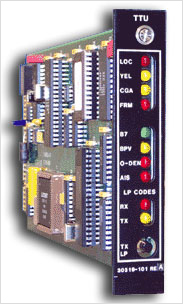
Drop & Insert Mux III D/I Mux III Special Feature Cards
Coastcom D/I
Mux III D/I Mux III
Special Feature Cards

Drop & Insert Mux III D/I Mux III Special Feature Cards

D/I Mux III Special Feature Cards
Data line cards interface various Data Terminal Equipment (DTE) directly with
D/I Mux III multiplexers, without the use of modems for full-duplex transmission
over T1 lines. Software-programmable data line cards support synchronous data
rates of 1.2 Kbps to 1.536 Mbps, and asynchronous data rates from 1.2 to 19.2
Kbps. Coastcom has developed specialty cards that meet specific product
applications.
D/I Mux III - ADPCM2 Channel Card
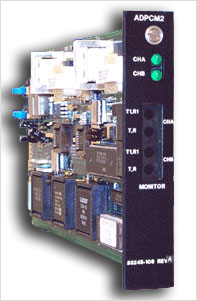
ADPCM voice compression enables the Dual 4-Wire E&M channel cards to reduce the
transmission rate to 32 kbps, thereby allowing two voice channels to be carried
on a single 64-kbps DS0 link. The ADPCM card is configured to accommodate two
intertoll trunks, as depicted in the graphic. The compressed voice signals used
in the ADPCM cards are virtually indistinguishable in quality from the original,
uncompressed voice signals. Coastcom’s ADPCM Dual 4-Wire E&M channel cards in a
D/I Mux III™ network effectively reduce voice-traffic bandwidth and thereby
increase your network’s carrying capacity. Using an Adaptive Differential Pulse
Code Modulation (ADPCM) algorithm, the Dual 4-Wire E&M cards double the number
of phone lines from the original 24 64-kbps channels to 48 32-kbps channels
carried by a T1 span.
Typical Applications
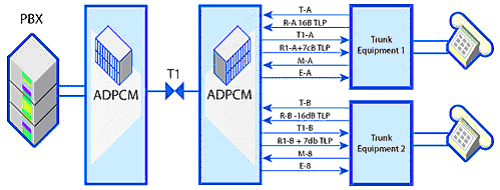
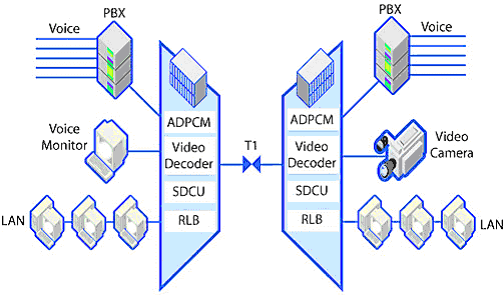
In typical applications (illustrated above), the ADPCM cards work in conjunction
with
Coastcom's other channel cards in a D/I Mux III network to integrate diverse
services. By consolidating voice circuits, the ADPCM cards free up space on your
leased line for the transmission of other media, such as data or video.
| Features | Benefits |
| G.726 ADPCM at 32 kbps: | 2:1 voice compression |
| Extended Range Analog Modem Transmission Level Points: | Accommodates a wide variety of interfaces Programmable Digital Transmission Level |
| Point (TLP): | Reconfigures between
standard and voice-grade data applications |
| Front Panel Test Jacks: | Makes testing convenient |
| Carrier Group Alarm (CGA): | Line conditioning |
| Extended T1 Signaling Formats: | Provides network flexibility |
| 5-year warranty: | Reliability guaranteed |
| ADPCM2 Channel Card Specifications | |
| Bit Rate | G.726 ADPCM at 32 kbps |
| Standard Transmit | -26.2 to 9.6 dBm TLP |
| Standard Receive | -16.2 to 8.6 dBm TLP |
| Adjustability | 0.1 dB steps |
| Accuracy | +/- 0.25 dB |
| 4-wire impedance | 600 ohms |
| Return loss | 1,004 Hz >28 dB; 300 Hz to 3,000 Hz >23 dB |
| Crosstalk | >65 dB (loss at 200 Hz to 3,400 Hz) |
| Idle channel noise | <20 dBrnCO (End-to-End) |
| CGA type I | E lead idle immediately |
| CGA type II | E lead busy immediately |
| CGA type III | E lead idle immediately followed by busy signal after several seconds of delay |
| Ignore CGA | Will continue to operate in CGA |
| Signaling types | E&M type I, II, III, V;PLR type I, II |
| Typical operating current | +5 V DC<250 mA;-5 V DC<18 mA;+12 V DC < 6 mA; -12 V DC<22 mA; -48 V DC Signal Battery |
| Operating Temperature | 0° to 50°C |
| Relative Humidity | < 95% non-condensing |
D/I Mux III - TTU Card
Tandem T1
Unit Coastcom's Tandem T1 Unit provides an additional T1 interface. The D/I Mux
III dual T1 multiplexer supports two trunk T1 interfaces. With the TTU, you can
add extra T1
interfaces as you would channel units.
Typical Applications
Feature Advantages
D/I Mux III - Video Encoder/Decoder Cards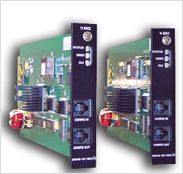
Tandem T1 Unit
Coastcom’s Video Encoder/Decoder Channel Cards provide D/I Mux III™ Intelligent
T1 Multiplexer users with the video component of a fully functional voice and
data system without requiring an external CODEC. The cards allow throughput of
real-time video with a minimal bandwidth requirement. With transmission rates of
64 kbps to 1.544 Mbps and up to 30 frames per second, each easy-to-program card
can be configured to use as little as one DS0 or a full T1 line for maximum
image quality.
A typical transportation application can include a strategically placed video
camera, road sensors, and pan-and-tilt devices to monitor traffic flow along a
stretch of heavily used highway. Video monitors in the traffic control center
provide managers of advanced traffic-management systems with the information
they need to dispatch emergency equipment in response to an accident or to
acknowledge a traffic slowdown as routine congestion.
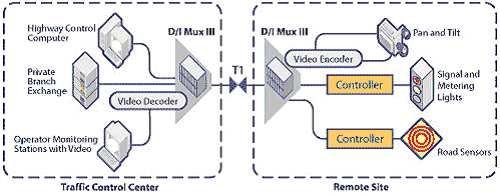
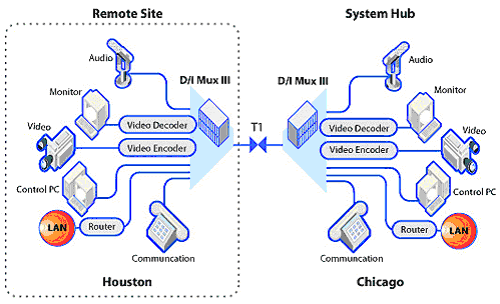
Typical Applications
A typical videoconferencing application can include Video Encoder/Decoder
Channel Cards, video cameras, PCs, and audio equipment connected to D/I Mux IIIs
at each site. Here a company with offices in Houston and Chicago use
videoconferencing to enhance communication and promote employee interaction.
| Features | Benefits |
| Data Rates between 64 kbps and 1.544 Mbps | Supports variable data rates |
| Self-contained programming quality factor | Easy to use |
| Programmable quality factor | User-defined quality |
| Variable video bandwidth allocation | Flexible |
| Control of pan-and-tilt and traffic controllers | Remote control |
| Frame rate of 30 per second | Full motion video available |
| Spatial resolution up to 720 x 625 | High resolution |
| 5-year warranty | Reliability guaranteed |
| Video Encoder/Decoder Card Specifications | |
| Input | SVHS or composite NTSC video |
| Output | SVHS or composite NTSC video |
| Data Format | RS-422 synchronous video |
| Data Rate | 64 kpbs to 1.544 Mbps (internally or externally selectable) |
| Refresh Rate | Up to 30 frames per second |
| Resolution | Up to 720 x 625 |
| Programming Port | RS-232 |
| Temperature | 0°to 50°C |
| Relative Humidity | < 95% non-condensing |
D/I Mux III – Fiber Interface Network Device (FIND)
Coastcom’s Fiber Interface Network Device (FIND) plugs into new or previously
installed D/I Mux III systems to reduce costs and increase T1 transmission
distances. With a range of up to 80kms, the FIND eliminates costly T1 repeaters
and increases noise immunity.
FIND handles up to 2 bi-directional T1 lines which can both be fiber or one
fiber T1 and one copper T1, respectively. Installation is a snap. Merely plug
the channel card in and connect the spans. No programming necessary. No set up.
No delay.
Lose nothing. Gain much.
While providing copper and fiber transmission, no D/I Mux features are
sacrificed. FIND supports ALPS (Automatic Loop Protection Switching) mode, dual
channel bank mode, and drop-and-insert mode. The Coastcom FIND adds 1:1
protection of the fiber span when used in dual T1 point-to-point configuration.
In channel bank mode, the fiber interface module provides APS (Automatic
Protection Switching) of fiber connections between D/I Mux systems. Switching
time between spans is less than 50msec. In fact, the APS function can be used on
a fiber span connected to T1-1 while simultaneously, T1-2 is operating over a
copper span.
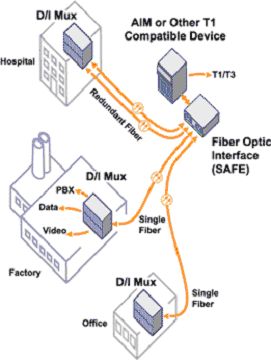
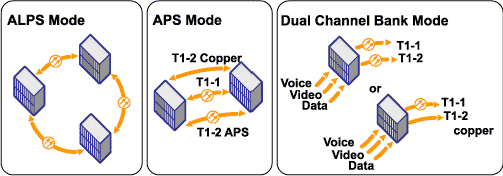
|
Transmitter: |
|||
| TYPE OUTPUT |
OUTPUT POWER |
APPLICATION
RANGE |
PART NUMBER |
| Dual Laser, singlemode, 1310nm | -10dBm | 40km | 30318-409 |
| Dual Laser, singlemode, 1310nm | -3dBm | 80km | 30318-411 |
|
Single Laser,
singlemode, 1310nm + single copper |
-10dBm | 40km | 30318-406 |
|
Single Laser,
singlemode, 1310nm + single copper |
-3dBm | 80km | 30318-408 |
|
Receiver: |
||
| TYPE | SENSITIVITY | OVERLOAD LEVEL |
| PIN Photodiode | -30dBm | 0dBm |
|
Specifications: |
|
|
Electrical interface |
DSX-1 (single) |
| Clock frequency: | 1.544MHz ± 200Hz |
|
Ambient |
Operating: -20° to 65° C Storage: -40° to 70° C |
| Altitude: | 10,000 ft. |
|
Humidity: |
0 to 95% non-condensing |
|
Controls: |
Switch selects APS mode. Push button to force span switch in APS mode. No programming required. Plug-and-play. Alternately can be controlled remotely via EMS |
|
Indicators: |
Power T1-1 Tx and Rx T1-2 Tx and Rx APS Active - colors indicate status |
|
Laser Life: |
150 years 40° C |
The Coastcom
D/I Mux III Drop-and-Insert Multiplexer
Call 301-924-7400 ext. 17
for Information and Pricing
Coastcom Products